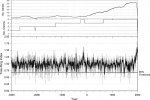- Joined
- Jan 28, 2013
- Messages
- 94,823
- Reaction score
- 28,342
- Location
- Williamsburg, Virginia
- Gender
- Male
- Political Leaning
- Independent
In this 22 minute video, Professor Nir Shaviv explains the role of the Sun in global warming -- a role studiously ignored by AGW advocates. An interesting side comment points to the publication soon of a paper following up on the groundbreaking Svensmark et al 2017.
[h=2]22 minute talk summarizing my views on global warming[/h][FONT="]Blog topic:
cosmic rays, global warming, personal research, politics, weather & climate
Just over a week ago I gave a 20 minute talk (which lasted almost 22 min) about the role that the sun plays in global warming in the Heartland institute's climate conference in DC. Here it is brought again for posterity. [/FONT]
[h=2]22 minute talk summarizing my views on global warming[/h][FONT="]Blog topic:
cosmic rays, global warming, personal research, politics, weather & climate
Just over a week ago I gave a 20 minute talk (which lasted almost 22 min) about the role that the sun plays in global warming in the Heartland institute's climate conference in DC. Here it is brought again for posterity. [/FONT]




